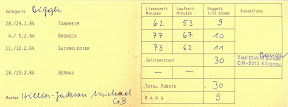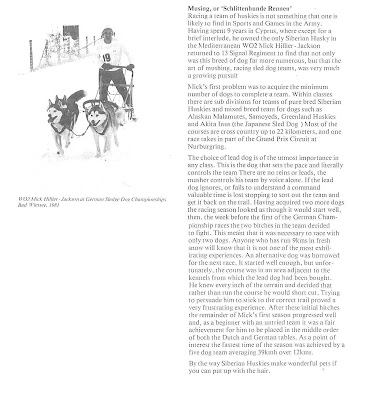
Exhilarating, definately; terrifying, sometimes: the most vivid memory of my husky racing period is bouncing down a mountainside near Bernau, in the Schwarzwald area of Germany, underneath the sled and with no way of getting the team to stop! It was probably one of the fastest runs I ever made!

To the questions: “Are you still racing” and “Do you still have Siberians”, the answer is no. The former is because one needs to live near the snow and to be extremely fit and the latter because, although huskies of various breeds are now common as pets, they are essentially working pack animals.

Having said this it was a wonderful period and I will be ever grateful to the support I got from the Royal Signals in particular, the Intelligence Corps and the army in general for sponsoring the vets bills and giving me the time off to train and race my team for the European Championships as well as a number of other club races. I should also include the REME whose workshop I borrowed to build my 8 dog travelling kennel which was based on a mini sun frame.

Not only did I get a great thrill out of racing but there was also some great sidelines, the main one acting as Father Christmas taking presents to schools on the last day of term.
A little bit about Schlittenhundrennen, Sled dog racing:
All races take place over two days and results are based on the combined times for the two runs. For the three dog class the distance is normally between 5 and 6 km and for 5 dogs 10 – 12 km. The big teams, 7 – 12 dogs run over around 20 km. Most of courses are round mountain tracks so one spends a great deal of time running behind the sled rather than standing on it.


For anyone interested the European championships were staged at 4 venues, Tannheim in Austria, Bernau in the Schwarzwald, Bruneck in the Italian Tyrol and Saignelégier in Switzerland.

One starts in the unlicensed class. To obtain a licence you have to compete in a number of races and finish within the average time set by the licensed teams. I got my licence after winning the Austrian and Italian 5 dog “Digger” class races in ’82. From there on one is competing for the Nugget Trophy against teams who can train on snow for most of the year. The best 3 results out of the four races count towards the trophy and one receives 1/10 gram of pure gold for every minute one is better than the average race time. e.g. If the average time for all runners over two days is 65 minutes and your time is 55 minutes you earn 1 gramme of gold.
My best placing was 9th out of about 22 teams and for this I won 3 grammes of gold (worth about £80 at today’s gold price).
It was quite a wrench when I left Germany for the last timer and had to sell my team, but they all went to other kennels so I knew they would be well looked after. Christine took Bambi back to the UK as he was really too old to go to a new team.

In ’83 a reporter from The Soldier came to Bruneck and wrote an article on my achievements. This was after I had qualified for my licence and hence the 7th place in the licenced class

I would pay tribute to my ex, Christine, without whose dedication I would never have achieved the success I did and whose love of the dogs (and taking them to shows ) knew no bounds.